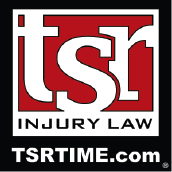Defensive Driving Tactics for Preventing Crashes in Minneapolis
Minneapolis drivers encounter various challenges, from congested urban streets and poorly lit suburban roads to unpredictable weather and heavy traffic.
Table of Contents
This article from TSR Injury Law explains some key defensive driving techniques. These tips can help you navigate challenging traffic and adverse weather conditions more safely, reducing your risk of a crash.
Were you injured in a collision? If so, you may be eligible to seek compensation for your medical costs and other damages. Need legal help? We encourage you to contact TSR Injury Law. Our experienced Minneapolis car crash lawyers have recovered over $1 billion for our clients. Call our trusted law firm today to discuss your situation and learn about your legal options.
Request your no-risk FREE case review today: (612) TSR-TIME.
What Is Defensive Driving?

Defensive driving is a set of skills and techniques that help drivers anticipate and respond safely to potential hazards on the road. The main goal of defensive driving is to reduce the risk of collisions by being proactive and prepared for unexpected situations. For example, when you are an alert driver, you will most likely notice a car swerving in and out of lanes. This gives you an opportunity to avoid that driver and a potential collision by moving into another lane, further away from the swerving car.
How Can Drivers Drive Defensively in Poor Weather Conditions?
Minneapolis faces some of the harshest weather conditions in North America, particularly during the winter months. These conditions make it crucial for drivers to practice safe driving. Snow, ice, rain and fog each present unique hazards that can increase the likelihood of car crashes.
Here are some of the most challenging driving conditions you can face in Minneapolis and some defensive techniques to help you to navigate them more safely.
Snow and Ice
During Minneapolis’s winters, drivers experience heavy snowfall and icy road conditions. Snow can accumulate quickly, covering the road and making it difficult for drivers to maneuver.
Ice, is an especially dangerous road hazard. Ice makes it challenging for drivers to maintain traction, increasing the risk of tires losing their grip on the road. Drivers who are unused to these conditions, or residents who have maybe gotten too used to them, may slide and lose control of their vehicles. This situation can quickly result in a crash.
Naturally, it is important to winterize your car and clear away all snow and ice from your vehicle before setting off. Stick to primary roads, as they are usually cleared first.
Here are some additional essential tips for driving in snow and icy conditions:
- Do not use cruise control
- Increase your following distance to 8-10 seconds
- Use low gears for better traction, especially on hills
- Slow down significantly, especially in high traffic areas
- Avoid sudden movements – accelerate, brake and steer gently to avoid skidding.
- Be extra cautious on bridges, overpasses, and shaded areas – they freeze first.
- If conditions are too dangerous, find a safe place to pull over and wait it out. Your safety matters most.
If you start to slide, it is important not to panic. Whatever you do, do not slam on the brakes. Instead, take your foot off the gas and steer in the direction you want to go.
Rain
During the warmer months, Minneapolis tends to experience heavy rain. Rainwater mixes with oil and debris on the pavement, creating a slick surface that significantly increases your risk of sliding or hydroplaning.
Even a thin layer of water can cause hydroplaning, so it is important to stay alert and focused on the road. Here are some key tips for helping you avoid slipping or hydroplaning in heavy rain:
- Avoid outer lanes where water pools
- Drive slower. Reduce your speed by at least 30 percent in heavy rain. This gives your tires more time to push water away.
- Increase following distance to at least 5 seconds
- Use headlights to improve visibility for you and helps other drivers to see you better as well
- Keep tires properly inflated and replace them when the tread is worn. Good tread depth helps prevent hydroplaning.
- Similar to driving on icy roads, do not use your cruise control and avoid sudden braking, accelerating or turning.
If you start to hydroplane, it is important to stay calm. Most people want to slam on the brakes, but do not do this. Instead, ease off the gas and hold your steering wheel straight. Drive in the tire tracks left by cars ahead of you. There will be less water there.
If rain is too heavy to see clearly, pull over to a safe spot and wait it out.
Fog
Fog often occurs during the early morning and late evening hours and can dramatically reduce visibility. This can make it difficult for you to see the road. It also makes it harder for drivers to see other vehicles, road signs and other obstacles. For example, dense fog can cause a driver to rear-end another car, especially if the vehicle behind the other car is speeding. Another way fog can cause a crash is if a driver is switching lanes and does not see other cars.
Some tips for driving in fog are similar to driving in other bad weather conditions, such as slowing down and not using cruise control. These are additional tips unique to driving through fog:
- Turn on your fog lights if you have them – do not use high beams as they will reflect off the fog and make it harder for you to see
- Roll your windows down a little to help you hear traffic you cannot see
- Use the right edge of the road as a guide to help you stay in your lane
- Do not follow any taillights you see too closely. You cannot predict whether that driver will need to stop suddenly.
If fog gets so thick that you can see nothing, pull off the road as soon as possible and turn on your hazard lights. Do not get out of your car as you could risk getting hit by passing traffic. Instead, stay in your vehicle and wait for conditions to improve.
Before You Go Out: Remember and Prepare to Drive Defensively
Minneapolis is known for having diverse driving conditions. From different traffic patterns, extreme weather conditions, construction zones and other potential hazards, drivers must stay focused on the road.
Along with the defensive driving tips we discussed, it is important to prepare your mind and your vehicle before you set off.
- Stay focused on the road and minimize your distractions
- Follow state and local traffic laws
- Yield to pedestrians, cyclists and other vulnerable road users
- Maintain safe following distances, and increase that distance as needed
- Check, clean and adjust mirrors before going out and use them effectively
- Properly prepare for lane changes, turns and merges by properly signaling and checking traffic
Manage Traffic Flow and Congestion
Traffic congestion is expected, especially during rush hours or morning commutes. In addition to using defensive driving techniques, build in some extra travel time. This one thing helps to reduce your stress about getting to your destination on time.
Practice Safe Parking
Parking safely in Minneapolis involves being aware of your surroundings and hazards. This is not a good time to be preoccupied by your phone. Choose suitable, well-lit spots and stay alert to traffic, people and obstacles around you.
Maintain Your Vehicle Regularly
Maintaining your vehicle is your responsibility. This duty includes servicing your brakes, replacing your tires or taking care of other critical maintenance. If neglecting your vehicle contributes to a crash, you could be held liable for the damages.
Navigate Construction Zones Safely
Navigating construction zones in Minneapolis requires extra caution due to frequent road projects. The law requires drivers to slow down in these areas for good reason. This gives you more time to notice and adhere to any construction signs, detours or lane closures.
Involved in a Minneapolis Car Crashes? Call a Trusted Lawyer Today
Car crashes can happen at the most unexpected moments, leaving victims with severe injuries and other damages.
If you or someone you know was involved in a car crash, we strongly recommend seeking legal help from a knowledgeable attorney.
Call our trusted law firm to learn about your potential legal options. At TSR Injury Law, we are prepared to help you navigate the legal process of recovering compensation.
Schedule Your Free Consultation today: (612) TSR-TIME.



